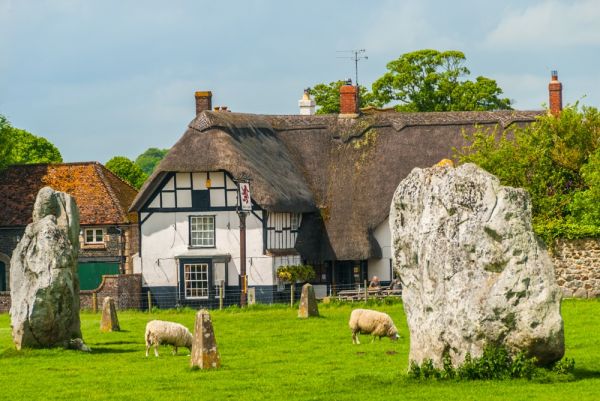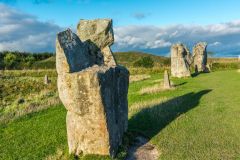
A huge Neolithic henge encircles much of the Wiltshire village of Avebury. The henge was begun around 2850 BC and altered several times over the following centuries until falling out of use around 2200 BC. This remarkable group of prehistoric monuments forms part of the Avebury World Heritage Site and makes up the most complex Neolithic henge in Britain.
The first part of the Avebury complex was the earthwork bank and inner ditch. Excavation shows that the ditch was originally about 30 feet deep, with the bank an equal height. Do your math - that makes for a 60-foot tall barrier! Though it is now covered in turf, the original henge would probably have left the underlying chalk exposed, making for a gleaming white bank and ditch.
Avebury Henge is astonishing in its scale, especially when you consider that the work of digging the ditch was done with nothing more than bone antler picks.
At some point, after the earthworks were complete timber structures were erected within the enclosure.

The Stone Square
We're all familiar with stone circles, but it seems certain that the first standing stone structure at Avebury was a stone square. In 2017 scientists investigating Avebury discovered evidence of two very early structures inside the henge. The oldest -- dating to the middle of the 4th millennium BC (sometime around 3500 BC) -- was a rectangular timber building roughly 6m x 10m. The date makes this the oldest feature at Avebury, built long before the henge.
Possibly at the same time but certainly within 200 years a square of at least 17 standing stones measuring 60m x 60m was built around the timber building. The sides of the square run parallel to the sides of the timber building, so there was a clear relationship between the two structures. This is the only stone square ever found.
If the dating is accurate, the timber structure and the stone square together must push the origins of the ceremonial site at Avebury back by up to 1000 years. Intriguingly, the stone square and timber structure are in the centre of a 3rd millennium stone circle about 100m across erected in the southern half of the henge. An identical stone circle was erected at the same time in the northern half of the henge.

There is a double avenue of stones leading away from the circle towards Overton Hill a mile and a half away, and it has been speculated by some archaeologists that the avenue was constructed to form the body of a snake, with the circle as the snake's head. The Avenue stones alternate from tall and thin to broad and trapezoidal, leading to more speculation that they represent males and females respectively.
A similar avenue led from the Avebury Henge to Beckhampton, though only a few standing stones now survive from the 'Beckhampton Avenue'.
The huge conical mound of Silbury Hill stands a mile south of the henge and is roughly contemporary with the henge, stone circles and avenues. With all these prehistoric monuments in such close proximity, it is clear that Avebury Henge and Stone Circles formed part of a much larger ceremonial landscape, probably involving some form of ritual procession.
The ceremonial purpose of the Avebury monuments must have changed and evolved over time as beliefs changed. The site appears to have been abandoned around 1800 BC.

The First Archaeologists
During the medieval period the pagan origin of the standing stones led to many of them being toppled or destroyed completely. Others were removed to make farming easier. It was not until the advent of antiquarians like John Aubrey and William Stukeley that any effort was made to understand the ancient monuments.
Both men sketched the stone circles and avenues, and though their theories about the origins of the sites and the society that produced them seem fanciful today, they did raise awareness of these ancient sites and their drawings help modern archaeologists find features that have since been lost or destroyed.
Following in the footsteps of Aubrey and Stukeley was Alexander Keillor, who lived at Avebury Manor. Keillor was the heir to the Keillor marmalade fortune, so he had the money to buy the entire Avebury site, clear away modern buildings, and study the monument. Keiller performed most of the excavations at Avebury, and his findings are revealed in the fine museum named after him which you will find just outside the gates of Avebury Manor.

What to See
The Avebury henge is roughly a quarter-mile across, enclosing an area of about 30 acres (12ha). The earthwork bank is roughly 5m high, eroded from its original 7m height. The bank varies from 20-30m thick at the base.
Within the bank is a flat-bottomed ditch that was originally up to 9m deep and 20m wide. Over 200,000 tons of chalk rubble was pried from the earth with antler tools to create the bank. There are four entrance causeways, in the north, south, east and west of the henge. These causeways were later used by the village road (east to west) and the A4361 (north to south).
Just inside the henge ditch is the Outer Stone Circle, composed of 100 standing stones. These stones are natural (i.e. unworked) sarsen stones and vary from 3-6m high. The largest stone weighs up to 20 tons. Of the original 100 stones, just 30 now survive. The locations of the missing stones are marked with concrete pillars.
Within the Outer Stone Circle are two smaller stone circles, the North Circle and the South Circle.
The South Circle had a diameter of 100m and was made with 29 standing stones, of which just 5 remain. At the centre of the South Circle stood a slender standing stone dubbed by William Stukeley 'The Obelisk'. The Obelisk stood within its own D-shaped arrangement of stones and was surrounded by small pits where a pottery vessel was discovered. The Obelisk was used for building stone in the 18th century and its location is marked by a concrete post.

The North Circle, in the north-east quadrant of the henge, was slightly smaller than the South Circle, measuring just under 100m across. Of the original 27 stones just 4 remain, though two of these have fallen. Within the North Circle was a triangular arrangement of stones known as The Cove, made of three stones.
Of these three stones just two remain, but they are among the largest and heaviest stones at Avebury. These impressive stones illustrate the 'male/female' theory of stones at Avebury; one is tall and slender (the male stone) while the other is shorter and very broad (the female stone).
There were originally two stone avenues running from the henge. Running from the southern entrance is West Kennet Avenue, a double row of standing stones that once stretched 1.5 miles to The Sanctuary on Overton Hill. West Kennet Avenue had 10 pairs of stones, alternately tall and slender and short and wide, possibly representing males and females respectively. Of the original 100 stones 27 remain, with the location of the missing stones marked by concrete posts.
A second stone row ran from the west entrance to the henge in the direction of Beckhampton. Of this row, only two stones known as The Longstones remain in a field near Avebury Trusloe village.
Several of the standing stones inside the henge are worth noting. In the north-eastern quadrant - close to the B4361 as it heads north out of the village - is the Swindon Stone. Presumably, the name comes from the fact that it is beside the main route north to Swindon.

The Barber Stone
In the south-west corner of the henge is the Barber Stone. During the 14th century local people tried to 'de-paganise' Avebury by felling and burying the stones. They did this by digging a hole beside a stone and toppling it into the 'grave'.
The attempt proved fatal for one unfortunate man, whose skeleton was found in a hole at the base of a large stone. He was buried with tools used by itinerant barber-surgeons including a leather purse holding a pair of scissors, a metal probe and a few coins. These metal scissors are among the earliest examples ever found in England.
The traditional interpretation of the evidence suggests that the barber-surgeon was helping topple a standing stone when it fell on him, trapping him in the hole and killing him. A more modern reinterpretation of the evidence suggests that the unfortunate man may already have been dead and was simply buried in a hole already dug for a standing stone.
The tools found with the barber-surgeon are on display in the Alexander Keillor Museum outside the gates of Avebury Manor. As for the skeleton, it is preserved at the Natural History Museum in London.

What is a henge?
The term 'henge' is often misused, perhaps because it is part of the name 'Stonehenge', which instantly conjures up an image of a large stone circle. But a henge is not the same thing as a stone circle; it is a circular earthwork enclosure defined by a bank and ditch with the bank on the outside of the circle and the ditch on the inside. Henges date to the period 3000 - 2000 BC (i.e. the late Neolithic to the Early Bronze Age).
Many henges, such as the ones at Stonehenge and Avebury, had a stone circle added inside the earthworks at a later date. Unlike other forms of Neolithic monuments, it is very rare to find fragments of pottery or bone in the ditch of a henge, suggesting that henges were not used for habitation.

What was Avebury Used For?
The short answer is that we don't know. They may have been ceremonial gathering places, perhaps related to the seasons or astronomical alignments at certain times of the year. Many henge entrances seem to be aligned on the midwinter or midsummer sunrise. Perhaps they were a form of calendar, a way of marking the passage of the seasons, which would have been enormously important to the farming communities that built them.
Avebury probably served as a religious and ceremonial centre, though what those beliefs or ceremonies were we do not know.
Both the village and the henge itself are under the care of the National Trust, and they also run Avebury Manor. There is a rural museum and gift and tea shops in the village.

Avebury vs Stonehenge
These two famous prehistoric sites are both in Wiltshire and are separated by only about 20 miles (as the crow flies). It is not surprising that the two sites are often compared. Let's look at a few of the common questions that arise.
Which is older?
The stone circle at Stonehenge is roughly contemporary with the henge and standing stones at Avebury, BUT newly discovered timber structures at Avebury suggest that Avebury was being developed up to 800 years earlier than Stonehenge.
Which is Cheaper?
Avebury. There is no charge to explore the henge, stone circles, and stone avenues at Avebury. There is a pay and display parking area, but this is free if you are a National Trust or English Heritage member. Stonehenge parking and admission charges are expensive, and though National Trust and English Heritage members do get free parking and admission, they still have to pre-book tickets to guarantee admission.
Do I need to Book Tickets?
Not with Avebury. Just show up (though be warned that things can get crowded at midsummer solstice). With Stonehenge you don't 'have to' pre-book tickets but if you don't then there is a good chance you won't get in, especially during the popular summer months. Pre-booking is also slightly cheaper.
Which is more crowded?
Stonehenge, by a landslide. Let's face it, Stonehenge is one of the most popular visitor attractions in England, and with good reason. But that popularity comes at a (literal and figurative) cost. It will be crowded. There will be a steady stream of tour buses disgorging eager visitors. Avebury is a peaceful haven compared to Stonehenge. You won't get photos that don't include other visitors taking photos. Avebury, by contrast, is heaven for photographers.
Can you wander among the standing stones?
At Avebury, you can. You also share the stones with grazing sheep. At Stonehenge visitors are kept at a distance from the stones to avoid damage to the stones and the surrounding landscape.
What about facilities?
Stonehenge has top-class visitor facilities with a gift shop, cafe, museum and toilets. Avebury is a village within part of an ancient henge. It has two independent gift shops, a village shop, toilets and a National Trust gift shop. There is also the Red Lion, a delightful thatched country pub located inside the henge.
So, which is better?
Avebury is my favourite prehistoric site in England. The 17th-century antiquarian John Aubrey agreed. He famously wrote that 'it does as much exceed in greatness the so renowned Stonehenge as a cathedral doeth a parish church'.
Don't get me wrong, Stonehenge is amazing, but I find Avebury more interesting and much more enjoyable to visit. One of the points in Avebury's favour is that you can wander in amongst the stones, which you cannot usually do at Stonehenge.
Avebury is accessible. The site is wonderfully open, in fact, you may think it is a bit too open as you carefully scrape sheep droppings off your shoes! Be warned, sheep wander through the fields and leave reminders of their presence everywhere. But aside from accessibility, Avebury is unique in that the village of Avebury lies partly within the henge, and a road splits the circle.
Avebury Henge and Stone Circles forms only one of numerous ancient sites in the neighbourhood. Just a few miles away is the strange conical mound of Silbury Hill, across the road from West Kennet Long Barrow. In the other direction is Windmill Hill causewayed camp, the finest hilltop camp in England. Avebury and its surroundings make for an incomparable day out exploring Britain's ancient past.
To get more out of your visit you can hire an audio guide to Avebury stone circle at the Henge Shop (available in English, French and Spanish).

Getting There
There is a small parking area in the village but that is reserved for residents. Many people are tempted to park at the Red Lion pub, but please only do that if you are planning to by a pint in the bar! Everyone else can park at the National Trust pay and display parking area on the Beckhampton Road (the A4361). Parking is free for National Trust and English Heritage members.
There is also a small layby on the B4003, at the southern end of the West Kennet Avenue, with room for several vehicles. From there you can walk up the stone row to the henge, a distance of about 0.5mile (1km).
About Avebury
Address: Avebury,
Wiltshire,
England, SN8 1RF
Attraction Type: Prehistoric Site
Location: 6 miles west of Marlborough on the A4361
Website: Avebury
Email: avebury@nationaltrust.org.uk
National Trust - see also:
National Trust memberships (official website link)
Location
map
OS: SU100 699
Photo Credit: David Ross and Britain Express
POPULAR POSTS
HERITAGE
 We've 'tagged' this attraction information to help you find related historic attractions and learn more about major time periods mentioned.
We've 'tagged' this attraction information to help you find related historic attractions and learn more about major time periods mentioned.
Find other attractions tagged with:
stone circle (Historical Reference) -
NEARBY HISTORIC ATTRACTIONS
Heritage Rated from 1- 5 (low to exceptional) on historic interest
Avebury Manor and Garden - 0 miles (Historic House) ![]()
Avebury, St James Church - 0.1 miles (Historic Church) ![]()
Alexander Keillor Museum - 0.1 miles (Museum) ![]()
West Kennet Avenue - 0.4 miles (Prehistoric Site) ![]()
Silbury Hill - 0.8 miles (Prehistoric Site) ![]()
Windmill Hill - 1.1 miles (Prehistoric Site) ![]()
Winterbourne Monkton, St Mary Magdalene Church - 1.3 miles (Historic Church) ![]()
West Kennet Long Barrow - 1.4 miles (Prehistoric Site) ![]()















